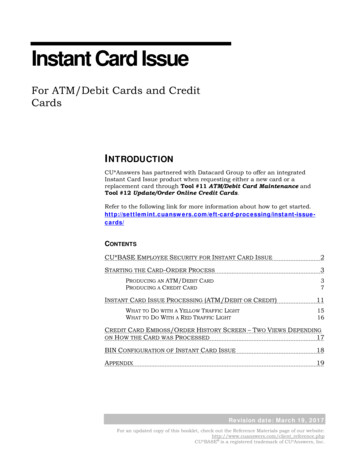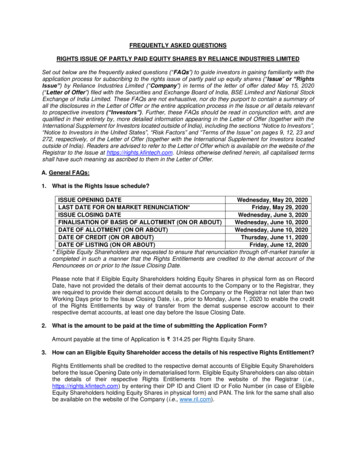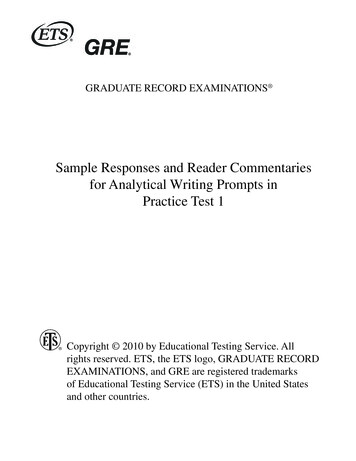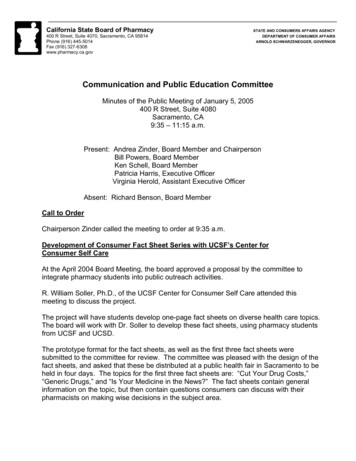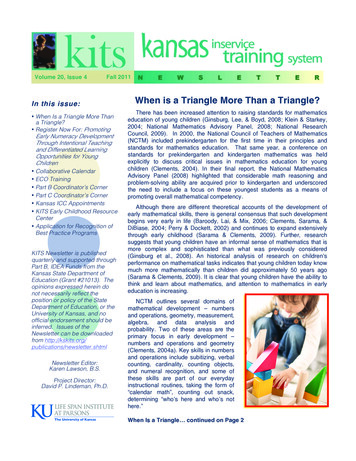
Transcription
Volume 20, Issue 4Fall 2011In this issue: When Is a Triangle More Thana Triangle? Register Now For: PromotingEarly Numeracy DevelopmentThrough Intentional Teachingand Differentiated LearningOpportunities for YoungChildren Collaborative Calendar ECO Training Part B Coordinator’s Corner Part C Coordinator’s Corner Kansas ICC Appointments KITS Early Childhood ResourceCenter Application for Recognition ofBest Practice ProgramsKITS Newsletter is publishedquarterly and supported throughPart B, IDEA Funds from theKansas State Department ofEducation (Grant #21013). Theopinions expressed herein donot necessarily reflect theposition or policy of the StateDepartment of Education, or theUniversity of Kansas, and noofficial endorsement should beinferred. Issues of theNewsletter can be downloadedfrom sletter Editor:Karen Lawson, B.S.Project Director:David P. Lindeman, Ph.D.The University of KansasWhen is a Triangle More Than a Triangle?There has been increased attention to raising standards for mathematicseducation of young children (Ginsburg, Lee, & Boyd, 2008; Klein & Starkey,2004; National Mathematics Advisory Panel, 2008; National ResearchCouncil, 2009). In 2000, the National Council of Teachers of Mathematics(NCTM) included prekindergarten for the first time in their principles andstandards for mathematics education. That same year, a conference onstandards for prekindergarten and kindergarten mathematics was heldexplicitly to discuss critical issues in mathematics education for youngchildren (Clements, 2004). In their final report, the National MathematicsAdvisory Panel (2008) highlighted that considerable math reasoning andproblem-solving ability are acquired prior to kindergarten and underscoredthe need to include a focus on these youngest students as a means ofpromoting overall mathematical competency.Although there are different theoretical accounts of the development ofearly mathematical skills, there is general consensus that such developmentbegins very early in life (Baroody, Lai, & Mix, 2006; Clements, Sarama, &DiBiase, 2004; Perry & Dockett, 2002) and continues to expand extensivelythrough early childhood (Sarama & Clements, 2009). Further, researchsuggests that young children have an informal sense of mathematics that ismore complex and sophisticated than what was previously considered(Ginsburg et al., 2008). An historical analysis of research on childrenʼsperformance on mathematical tasks indicates that young children today knowmuch more mathematically than children did approximately 50 years ago(Sarama & Clements, 2009). It is clear that young children have the ability tothink and learn about mathematics, and attention to mathematics in earlyeducation is increasing.NCTM outlines several domains ofmathematical development – numbersand operations, geometry, measurement,algebra, and data analysis andprobability. Two of these areas are theprimary focus in early development –numbers and operations and geometry(Clements, 2004a). Key skills in numbersand operations include subitizing, verbalcounting, cardinality, counting objects,and numeral recognition, and some ofthese skills are part of our everydayinstructional routines, taking the form of“calendar math”, counting out snack,determining “whoʼs here and whoʼs nothere.”When Is a Triangle continued on Page 2
Page 2 of 9When Is a Triangle continuedFurther, these skills may seemintuitive as part of mathematicsinstruction in the early educationclassroom. Geometry, on the otherhand, may not receive as muchattention in the classroom beyondthe naming of basic shapes. Giventhat childrenʼs notion of shape, akey concept in geometry, becomesstable as early as 6 years of age(Clements & Sarama, 2009), it isessential to draw attention to theimportance of this area in childrenʼsdevelopment. Further, geometry isbroader than shape as we typicallythink of it, and includes spatialorientation, visualization, and reasoning (Clements & Sarama, 2009).Geometric and spatial reasoningform the foundation of muchlearning of mathematics and othersubjects such as science, engineering, art, and architecture (Clements,2004b; NCTM, 2000; NationalResearch Council, 2009; Sarama &Clements, 2009). Geometry skillshelp young children mentally structure the spaces and objects in theirworld and provide a context for thedevelopment of mathematical reasoning (National Research Council,2009), and shape, a typical skillemphasized in the preschool years,is a key element in cognitive development beyond geometry (Sarama,& Clements, 2009). In terms ofdevelopment,childrenʼsinitialschemas for shape are linked tolanguage through experience andinteraction. These verbal interactions help to guide childrenʼsattention to the features of shapes.Initially, childrenʼs sense of shaperemains strongly connected toprototypical examples. Throughmore elaborate experiences withshape and integration of verbal andimagisticknowledge,childrenbecome more flexible in theirthinking about shape (Sarama &Clements, 2009). The focus of skillFall 2011 KITS Newsletter, kskits.orgdevelopment in this area over theperiod of 3 to 5 years is oncomparison, classification, parts of,and representation of shapes.Development in this area is characterized by increasing flexibility inthinking about shape and expansion of the attributes of shape thatare considered. Children alsoincrease their ability to composeand decompose shape.Among the skills that should beemphasized in preschool to helpchildrendevelopfoundationalgeometry and spatial thinking arethe ability to recognize basic twodimensional shapes (e.g., square,circle, triangle), variations of twodimensional shapes (e.g., basicshapes of different sizes andorientations), basic three-dimensional shapes (e.g., cube, sphere),and more abstract shapes (e.g.,rhombus,hexagon;Clements,2004a; 2004b; NCTM, 2000;National Research Council, 2009;Sarama & Clements, 2009). Areview of preschool mathematicscurricula indicates that targetshapes may include two-dimensional shapes of circle, square,triangle, and rectangle along withthree-dimensional shapes such ascube, sphere, and cylinder. Clearly,shape is much more complex thansimply naming shapes and shouldinclude multiple experiences withshapes, including manipulativesand construction activities.The kinds of shapes that childrenexperiment with can also go beyondthose found in typical curricula toinclude quadrilaterals, trapezoids,rhombi, and hexagons (we mightneed to refresh our own memorieshere about these shapes). Ifchildren can remember the namesof dinosaurs and their variousdefining features, than surelylearning about trapezoids and theirdefining attributes is not a greatleap. We need to take advantage ofchildrenʼs natural curiosity and extend their geometrical thinking incomplex ways.By age three, children shouldbegin recognizing, matching, andcomparing typically-oriented shapes,and by age four, they should beable to do the same with shapes ofless typical orientations (Sarama &Clements, 2009). In teaching aboutshapes, it is important to includeshapes in various forms (e.g.,elongated rectangle, right triangle,isosceles triangle) and in variousorientations (i.e., horizontal orvertical). Providing children withmultiple examples of shapes indifferent forms and orientationsincreases the flexibility with whichchildren think about shape andencourages the use of attributes indefining shape. That is, an elongated triangle is still a trianglebecause it has three angles orcorners and three straight sides.Children should also develop skillsin combining shapes into picturesand synthesizing combinations ofshapes into composite shapes(Clements, 2004a;When Is a Triangle concludedon Page 3
Page 3 of 9Fall 2011 KITS Newsletter, kskits.orgWhen Is a Triangle conclusion2004b; NCTM, 2000; National Research Council, 2009; Sarama& Clements, 2009). These skills are related to childrenʼs spatialvisualization abilities and typically involve understanding andtransforming shapes by sliding, flipping, and turning mentalimages of two and three-dimensional shapes.To promote geometrical thinking in young children, we needto go beyond a unit on shapes in our own thinking. We need tosee shape connected to geometry in a meaningful way thatincludes two-dimensional and three-dimensional shapes,attributes of shapes, geometric motions, and spatial thinking.Clements and Sarama talk about “mathematizing” childrenʼsexperiences. To do so, we need to further develop our ownknowledge base to be able to engage in rich interactions thatsupport childrenʼs mathematical competencies.When we do this, our children expand theirknowledge and skills in a way that sets them ona course for mathematics success. Most simply,a triangle becomes much more than this.References:Clements, D. H. (2004a). Part one: Major themes andrecommendations. In D.H. Clements, J. Sarama, & A. M. DiBiase(Eds.), Engaging young children in mathematics education:Standards for early childhood mathematics education (pp. 1-72).Mahwah, NJ: Erlbaum.Clements, D. H. (2004b). Geometric and spatial thinking in earlychildhood education. In D.H. Clements, J. Sarama, & A. M.DiBiase (Eds.), Engaging young children in mathematicseducation: Standards for early childhood mathematics education(pp. 267-297). Mahwah, NJ: Erlbaum.Clements, D. H., & Sarama, J. (2009). Learning and teachingearly math: The learning trajectories approach. New York, NY:Routledge.National Council of Teachers of Mathematics. (2000). Principlesand standards for school mathematics. Reston, VA: Author.National Mathematics Advisory Panel (2008). Foundations forsuccess: The final report of the National Mathematics AdvisoryPanel. Washington, DC: U.S. Department of Education.National Research Council (2009). Mathematics learning in earlychildhood: Paths toward excellence and equity. Washington, DC:National Academies Press.Sarama, J., & Clements, D. H. (2009). Early childhoodmathematics education research: Learning trajectories for youngchildren. New York, NY: Routledge.Article submitted by Robin Hojnoski, Ph.D. and Joy Polignano,Lehigh University.REGISTER NOW FORPromoting Early NumeracyDevelopment ThroughIntentional Teaching andDifferentiated LearningOpportunities forYoung ChildrenPresenter: Robin Hojnoski, Ph.D.October 20, 2011 in TopekaOctober 21, 2011 in WichitaThis workshop will provide early childhoodprofessionals with a greater understandingof the development of early mathematicalskills in young children and the role of theadult in providing intentionally designedlearning experiences that are developmentally appropriate and evidence based.Participants will learn how the development of mathematical understandingbegins in infancy and continues as a moreformal concept of number is developedthrough the toddler and preschoolyears. This ever-developing concept ofnumber referred to as "early numeracy" willbe discussed, focusing on examples oflearning experiences that promote specificconcepts such as subitizing, cardinality,verbal counting, and the relationshipamong numbers.Participants will also learn systematicapproaches to collecting and usingassessment data to improve instructionand monitor progress of individuals as wellas groups of children.No cost. Lunch and materials are provided.Register early. Space is limited.Register online at:https://www.surveymonkey.com/s/VPPWRXVFor more information on this and a variety of other training opportunities,go to the KITS Collaborative Training Calendar at:http://www.kskits.org/ kskits/cgi-bin/CollCal/EventListing.php
Page 4 of XXFall 2011 KITS Newsletter, kskits.orgThe Collaborative Calendar of EventsView at 3/12EVENT/CITYBirth to Five Regional Summits 2011 –Transition Planning Through Teamwork- EmporiaBirth to Five Regional Summits 2011 –Transition Planning Through Teamwork- Topeka2011 KASP Fall Convention: Interventions:Practical solutions for the School Psychologist- ManhattanBeyond the Diagnosis: Autism Across the LifeSpan – Overland ParkAges and Stages Questionnaire 3 Training TopekaEarly Childhood Outcomes: Using the ChildOutcome Summary Form (COSF) to ReportProgress - TopekaFocus on IEPs- ManhattanEarly Childhood Outcomes: Using the ChildOutcome Summary Form (COSF) to ReportProgress - NewtonPromoting Early Numeracy DevelopmentThrough Intentional Teaching andDifferentiated Learning Opportunities for YoungChildren - TopekaPromoting Early Numeracy DevelopmentThrough Intentional Teaching andDifferentiated Learning Opportunities for YoungChildren - WichitaEarly Childhood Outcomes: Using the ChildOutcome Summary Form (COSF) to ReportProgress – Garden CityGovernorʼs Conference for the Prevention ofChild Abuse & Neglect - TopekaParents as Teachers Conference 2011 – EarlyChildhoodʼs Role in the Education Continuum- St. Louis, MOKansas Basic Home Visitation Training- SalinaPart C Coordinators Meeting- Location TBAPart C Regional Meetings- ITVth30 Annual KDEC Conference: EvidenceBased Practice: Real Life Applications WichitaCONTACT / http://blogs.jccc.edu/autism/Marita Douglas or Nancy Keel at //www.kcsl.org/training rg/node/373Registration - TBARegistration - TBARegistration - TBA
Page 5 of 9Fall 2011 KITS Newsletter, kskits.orgEarly Childhood Outcome Training for 2011-2012The Kansas Department of Health and Environment(KDHE) Part C Infant Toddler Services and theKansas State Department of Education (KSDE) Part BPreschool Programs have developed a collaborativesystem for collecting and reporting Early ChildhoodOutcome (ECO) data as required by the U.S.Department of Education, Office of Special EducationPrograms (OSEP). ECO data is used at both thefederal and state levels to examine the effectivenessof programs serving children with disabilities from birththrough age five. Every state is required to implement,monitor and make improvements to a State Performance Plan (SPP) that addresses federal priorities orindicators of performance.Performance on the ECOs is one of the indicatorsmeasured in every SPP. It is one of 20 total indicatorsfor Part B and one of 14 indicators for Part C. It is alsoone of two indicators shared by both Part C and Bprograms. The transition between Part C and B is theother shared indicator. States are required to setrigorous targets for SPP indicators and report annualprogress toward meeting the targets. In the spring of2010, ECO data were included for the first time in thedata used to make local determinations for KansasPart C networks and school districts on their annualperformance reports.To ensure that Kansas early childhood specialeducation professionals have the most currentguidance regarding ECO reporting, we have designeda variety of training events and materials for 2011 and2012.KITS Hosts Webinar EventstndOn August 31 and September 2 , more than 135sites participated in three Kansas Early ChildhoodOutcome Update webinar sessions. These weredesigned to provide early childhood special educationprofessionals with an overview of the requirements forcompleting ECO ratings using the Child OutcomeSummary Form (COSF) and entering ratinginformation into the Outcome Web System (OWS). Arecorded version of one of the webinar is posted at:https://desktop connect.ku.edu/p6av03gwnmu/, alongwith the Power- Point slides. A Q&A document basedon the questions and answers from each of the threewebinar sessions will also be posted soon.Regional ECO TrainingIn October, KITS will provide three regional trainings:Early Childhood Outcomes: Using the Child OutcomeSummary Form to Report Progress. These half-dayregional workshops are designed to be an introductionto the team process for completing ECO ratings usingthe COSF. They were designed specifically for staffnew to the ECO rating process or those who would liketo review the requirements for completing a COSF.Dates and locations are as follows. Thursday, October 13, Topeka & Shawnee CountythPublic Library, 1515 SW 10 Avenue, Topeka Tuesday, October 18, McKinley AdministrativeCenter, 308 First Street, Newton Friday, October 28, Garden City Community CollegeStudent Center, Endowment Room, 801 CampusDrive, Garden CityFor further information or to register, go to http://www.kskits.org/ kskits/cgi-bin/CollCal/EventListing.php.KITS Website ResourcesOur website is the official repository for Kansas ECOresources and training information. hisrichresource includes a section for Hot Topics where newinformation is posted, and a link to the OWS Login andUser Guide. There are pages specific to administrators,data entry personnel, direct service providers, andthose who are training new staff. Materials are postedfor individual and group training, as well as casestudies that include example COSFs.Upcoming Training & ResourcesKDHE, KSDE and KITS are developing writtenguidance and training related to understanding andusing ECO data. A document is planned that willprovide local networks and districts with information,investigative questions and strategies for understanding patterns in ECO data. A future webinarand/or training sessions will be held in the spring of2012 to introduce the Data Drill Down document andstrategies.To keep current on ECO resources, be sure tocheck the Kansas ECO webpage. Information aboutnew resources and training will also be sent outthrough the KITʼs list serves, posted on the KITSFacebook page and/or posted on the KITʼsCollaborative Training Calendar.Submitted by Chelie Nelson, Ph.D.KITS, Early Childhood TechnicalAssistance Specialist316-440-6634chelie.nelson@ku.edu
Page 6 of 9Part B ECSE PreschoolCoordinatorʼs CornerBirth to Five Regional Summits:Transition PlanningThrough TeamworkTransition From Part C to Part BECSE PreschoolFall 2011 KITS Newsletter, kskits.orgNeed to UpdateContact Information?If you would like to add or update Part B ECSEcontact information, please contact Beccy Strohmat bstrohm@ksde.org. To add or update Part Cinformation, please contact Diane Alexander atdalexander@kdheks.gov.Part B Indicator 12 / Part C Indicator 8Outcomes Web System (OWS)Just about the time this newsletter is posted,staff from the KDHE, the KSDE, SRS, and KITSwill be meeting across the state to assist localprograms with the new requirements and toprovide resources and other technical assistance.The regional summits were scheduled as follows. 9/27/11 in Dodge City 9/28/11 in Newton 10/4/11 in Emporia 10/5/11 in TopekaPart B Indicator 7 / Part C Indicator 3The morning sessions will focus on localcommunity program discussions and plans forsmooth transitions for children and families whomay access more than one early childhoodprogram or move from one early childhoodprogram to another. The afternoon sessions willfocus around the requirements for Part C to Part Btransitions and will also include discussions aroundthe state level memorandum of understanding withParts C and B.Please watch our state agency websites forupdated information following the regional summits.KSDE Early ChildhoodSpecial Education Webpagehttp://www.ksde.org/Default.aspx?tabid 4745KSDEʼs Special Education Services, EarlyLearning Service Unit (ELSU) provides updatedinformation for ECSE. This includes Part BECSE contacts across the state as well as theKDHE Part C tiny-k tmlPlease visit this KITS website to review theupdated OWS User Guide that is now available asa webpage with links for easier access.Early Childhood Outcomes (ECO)Part B Indicator 7 / Part C Indicator 3Along with the recent ECO webinar that willsoon be posted, there are many other resourceson the KITS website, including COSF rs, data entry staff and direct serviceprovider to assist with verification of program data.Child Outcome SummaryForm (COSF) Regional TrainingPart B Indicator 7 / Part C Indicator 3Please go to the KITS Collaborative TrainingCalendar if you have new staff that needs trainingon completing the ECO ratings using the ChildOutcome Summary Form (COSF). These workshops will include a review of the ECO timelinesand process, as well as case study examples withhands-on experience in completing COSF ratingsthat meet our state requirements. (See date andlocation information on Page 5 of this newsletter.)Submitted byTiffany Smith,Early Childhood Part BECSE Coordinator785-296-1944tsmith@ksde.org
Page 7 of 9Fall 2011 KITS Newsletter, kskits.orgPart C Coordinatorʼs CornerKDHE OSEP VerificationVisit First ImpressionsAs you know, we had the pleasure of having theOffice of Special Education Programs (OSEP) visit ourState during the week of August 22, 2011. They werevery impressed with the services that the children andfamilies are receiving in Kansas and were extremelypleased with how we work together. We are all doinga wonderful job of building the capacity of families tomeet the needs of the children in Kansas InfantToddler Services. We have a lot to be proud of.The challenge of leadership is to be strong, butnot rude; be kind, but not weak; be bold, but notbully; be thoughtful, but not lazy; be humble, butnot timid; be proud, but not arrogant; havehumor, but without folly. Jim RohnThis quote sums up my feelings after the OSEPvisit. By now all of the Network Coordinators havereceived an email message from me regarding theimmediate implications from the OSEP visit.During the visit we had many things clarified, one ofwhich is how we (KDHE) have been identifying, or notidentifying, situations of non-compliance and timelycorrection of non-compliance. It was brought to ourattention that we have not been citing networks orcorrecting non-compliance as we should.In response to OSEPs concerns, we are in theprocess of developing in-depth General SupervisionGuidelines, a long-term monitoring plan andnoncompliance procedure. These will be added to theProcedure Manual and be made available as soon asthey are completed. We will not hear back from OSEP“officially” until sometime in November, so I suspectthat we will not have the guidelines available untilsome time in late winter or next spring, especially withthe issuance of the final federal regulations.One Last Part C item:The Part C Federal Regulationshave finally been released. fants-andtoddlers-with-disabilitiesOn September 28, 2011, the U.S. Department ofEducation announced the release of the finalregulations for the early intervention program underPart C of the Individuals with Disabilities Education Act(IDEA). The official version of these regulations can befound at the above web link.Remember that we really do know that our localnetworks are doing a great job with the coremission of delivering quality services to childrenand families in Kansas, and they are out thereworking their tails off.On behalf of everyone at KDHE, thank you!Submitted by Sarah WaltersPart C Infant-Toddlertiny-k Coordinator785-296-2245swalters@kdheks.govKANSAS ICC APPOINTMENTSThe Coordinating Council on Early ChildhoodDevelopmental Services (Kansas ICC) is pleased toannounce several new appointments. Governor SamBrownback has appointed Jill Bronaugh, of Topeka,to serve as parent of a child with a disabling condition.She will replace Richard Martinez. The Governor hasalso appointed Janice Smith, of Wichita, to serve as aprovider of early intervention services member. Shewill replace Tom Kohmetscher. Both will serve fouryear terms on the Council.Legislative leadership has also appointedRepresentative Gail Finney, a Democrat fromWichita and Senator Jean Schordorf, a Republicanfrom Wichita. They replace Representative BarbaraCraft and Senator Laura Kelly.The Kansas ICC has the statutory mission to adviseand assist on all matters pertaining to young childrenaged birth through five years of age who areexperiencing a developmental delay/disability, andtheir families. We would like to thank those who havedevoted years of service to the Council.Submitted by Doug Bowman, Coordinator785-296-1294 or dbowman@kdhe.state.ks.us
Page 8 of 9Fall 2011 KITS Newsletter, kskits.orgEarly Childhood Resource CenterNEW TO THE ECRC Zimmerman, I., Steiner, V., Pond, R. (2011). PreschoolLanguage Scales (5th ed.). Bloomington, MN. PearsonAssessment. Aspy, R., Grossman, B. (2008). The Ziggurat Model.Shawnee Mission, KS. Autism Asperger Publishing Co. Kansas State Department of Education. (2011) KansasSpecial Education Services Process Handbook.Topeka, KS. KSDE. Claire, L., Seibel, N., Parlakian, R. (2011). Parents andProviders: Sharing the Care. Washington, DC. Zero toThree. Kelly, J., Zuckerman, T., Sandoval, D., Buehlman, K.(2008). Promoting First Relationships (2nd ed.). Seattle,WA. NCAST-AVENUW Publishing. Allen, E., Cowdery, G. (2011). The Exceptional Child:Inclusion in Early Childhood (7th ed.) Belmont, CA.Wadsworth Cengage Learning. MacDonald, J. (2004). Communicating Partners: 30Years of Building Responsive Relationships with LateTalking Children including Autism, AspergerʼsSyndrome (ASD), Down Syndrome and TypicalDevelopment. Philadelphia, PA. Jessicas KingsleyPublishing. MacDonald, J., Stoika, P. (2007). Play to Talk: APractical Guide to Help Your Late-Talking Child Jointhe Conversation. Madison, Wisconsin. KiddoPublishing. Cook, R., Sparks, S. (2008). The Art and Practice ofHome Visiting. Baltimore, MD. Brookes Publishing. Cross, C., Woods, T., Schweingruber, H. (Eds.). (2009).Mathematics Learning in Early Childhood: PathsToward Excellence and Equity. Washington, DC. TheNational Academies Press. Rogers, S., Dawson, G. (2010). Early Start DenverModel for Young Children with Autism: PromotingLanguage, Learning, and Engagement. New York. TheGuilford Press. Cook, R., Klein, M. Tessier, A. (2008). Adapting EarlyChildhood Curricula for Children with Special Needs.Upper Saddle River, NJ. Pearson/Merrill/ Prentice Hall. Schertz, H., Wong, C., Odom, S. (Eds.). (2010).Supporting Young Children with Autism SpectrumDisorders and Their Families. Missoula, MT. Divisionfor Early Childhood.Contact theKITS ECRCKim Page, Coordinator620-421-6550 ext. 1651800-362-0390 ext. 1651fax: 620-421-6550 ext. 1791web: www.kskits.org/ecrcemail: resourcecenter@ku.eduaddress: 2601 Gabriel,Parsons, KS 67357Individual Growth &Development Indicators (IGDIʼs)The Individual Growth & Development Indicators(IGDIʼs) is now available for review. GDIs are used tomonitor the language and literacy development ofpreschoolers, 3-5 years of age. Quick, efficient andrepeatable; IGDIs measure the growth of youngchildren over time toward important developmentaloutcomes. The IGDIs test is comprised of three keymeasures: Picture Naming (an assessment ofexpressive language development), Rhyming, andAlliteration (assessments of phonological awareness).Successful adoption of these skills is known to benecessary for later reading success.IGDIs place a special emphasis on assessmentrelated to long-term developmental outcomes that arerelated to ongoing competence in home, school, andcommunity settings. IGDIs have been empiricallyvalidated in a series of studies at the University ofMinnesota and are used in a wide number of settingsacross the United States.The administration of IGDIs is designed to berepeated multiple times to track the developmentalprogress of children over a period of time. There aretwo methods for monitoring student scores, one is feebased and one is free. Both are online. The feebased method allows you to generate fullycustomizable reports for tracking childrenʼs progressover time, compare student performance across thenation, state, school district/program, school, or eventhe classroom average, share student reports withparents, track individual students, analyze group data,and measure outcomes of targeted intervention.To review the IGDIʼs, contact the ECRC atresourcecenter@ku.edu.Downloaded from: http://igdis.umn.edu/ on 9/14/2011.
Page 9 of 9Fall 2011 KITS Newsletter, kskits.orgKansas InserviceTraining SystemContact KITS by Phone:620-421-6550 ext. 1618Toll free in Kansas at800-362-0390 ext. 1618APPLICATION FORRECOGNITION IN BEST PRACTICE Fax:620-421-0671 E-Mailkskits@ku.eduThe Kansas State Department of Education (KSDE) and the KansasDepartment of Health and Environment (KDHE) identify, on a yearly basis,as many as three early intervention and as many as four early childhoodpreschool programs from across the state that demonstrate application ofbest practice in a component of their program.Weʼre on the Web!http://www.kskits.orgApplications for the 2012 awards have been sent to all subscribers ofthe KITS Infant-Toddler Network, Preschool Programs and NetworkCoordinator list services. Application packets are also available todownload from this KITS website link.Training for EarlyChildhood Professionalsand FamiliesApplication for Recognition in Best PracticeThe University of Kansas is anEqual Opportunity/AffirmativeAction Employer and does notdiscriminate in its programs andactivities. Federal and statelegislation prohibits discriminationon the basis of race, religion, color,national origin, ancestry, sex, age,disability, and veteran status. Inaddition, University policies prohibitdiscrimination on the basis ofsexual orientation, marital status,and parental status.Submitted applications will be reviewed by a panel of Kansasprofessionals in the fields of ear
early mathematical skills, there is general consensus that such development begins very early in life (Baroody, Lai, & Mix, 2006; Clements, Sarama, & DiBiase, 2004; Perry & Dockett, 2002) and continues to expand extensively through early childhood (Sarama & Clements, 2009). Further, research



